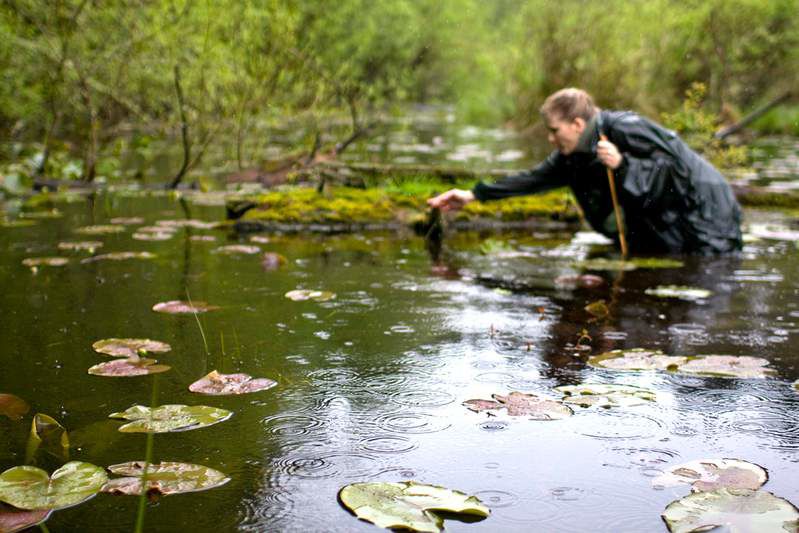Rare floating peat mat is preserved
Published 5:00 am Saturday, May 16, 2009

- Katy Weil, a Metro employee, explores the Peach Cove Fen in rural West Linn. Metro purchased the property that contains what is believed to be the last “fen in the Willamette Valley. Fens, as in Fenway Park, are bog-like areas.
WEST LINN — It’s like walking on a waterbed. The ground — or more accurately, the mat — gently sinks, bobs and quivers with every step.
Pause a second to take this in. You’re walking on a carpet of interwoven, bright green, peat moss that is 12 to 30 inches thick. Water oozes in every depression. Graceful spiraea shrubs and twirling buckbean plants spring from the peat, their roots eternally wet. Grassy clumps of inflated sedge fill the spaces in between, while thin coils of native blackberries snake where they can.
And it floats, all of it. This bobbing cacophony of wet green life near West Linn, called a peat mat, is floating in a shallow lake crowded with blooming water lilies and underwater bladderwort. Douglas firs tower above the clear water, poplars and ash trees compete for the best spots along the bank. Unseen hawks and warblers call from the trees.
This spot, closer than seems possible to the commuter clog of Interstate 205, is called the Peach Cove Fen. And now you own it, as part of a taxpayer-underwritten program to preserve extraordinary patches of the metropolitan area.
It is more than just another pretty wetland, it is downright rare. It’s the only remaining fen in the Willamette Valley, and some of the plants crowning the floating peat mat aren’t found anywhere else in the Valley.
Which is enough to make scientists go nuts. When wetlands ecologist John Christy of the Oregon Natural Heritage Program first saw the fen about 12 years ago, “All the little bells went off,” he says. “Rare plants, floating mat.
“There’s nothing else like it in the Willamette Valley.”
Fens are distinguished from bogs or swamps by their water chemistry and the accumulation of peat, which builds up because the organic material in the water-logged soil is slow to break down.
The Peach Cove spot began as a depression scoured by the Missoula Floods at the tail end of the ice age, 13,000 to 15,000 years ago. It’s fed solely by rain runoff, and the floating mat rises and falls with winter rain and summer dry spells.
Minnesota has a bunch of them, and Boston’s Fenway Park takes its name from a fen. But the other low-elevation fens in Oregon — there may have been some on Sauvie Island and in Marion County — were most likely drained and filled for farmland a century ago.
Peach Cove Fen, tucked away off a country road in the Willamette Narrows area, never had that pressure. And now it never will, thanks to voters who provided bond money for Metro’s natural spaces acquisition program, and to property owners who thought beyond themselves.
The fen was a matter of insider knowledge to biologists and students for years before Metro came calling. It was set up against a hillside, part of a much larger property, and generations of owners never saw the need to drain and convert it.
By the time Bruce and Mary Kahre inherited it from her parents in 2005, it was simply a place to enjoy deer, ducks and bullfrogs — and to host the occasional visiting scientist.
The family sold an adjoining 50 acres to Metro 10 years ago and granted the regional government a first right of refusal on the remaining 13 acres, which contained the fen. Last fall, the Kahres decided it was time to sell and approached Metro with the news.
Using money provided when voters approved an open spaces bond measure in 2006, Metro paid $795,000 for the property, which includes the Kahres’ house. The couple will rent it back from Metro for the time being.
Preserving the fen is critical as Portland and its suburbs grow, Bruce Kahre says. The current zoning prohibits development, but zoning designations can be changed, he notes.
“We don’t want it developed,” Kahre says. “It’s so pristine, so close to the metropolitan area. It would have killed us to know a bunch of houses were built around this.” So the peat mat will continue to bob and quiver. “Until long after we’re gone,” as Kahre puts it.
And amid the green beauty is natural death. Leading a tour, Katy Weil, Metro’s wildlife monitoring coordinator, comes across the bleached bones of a two-point blacktail deer. Skull and antlers, spinal column and ribs laid out in a fatal arc. Whether it was tracked by a predator, laid low by disease or bogged down in the oozing mass is an unanswerable question. Weil examines the skull, looking for signs. Then she gently, respectfully, returns it to its resting place.
It’s not a time or place to play “CSI Deer Skeleton,” she says.
Because in the fen, you leave things be.






